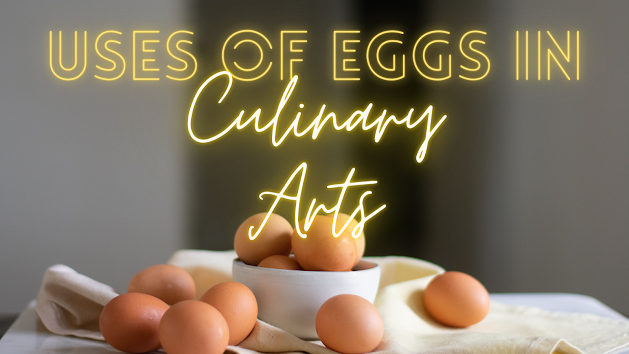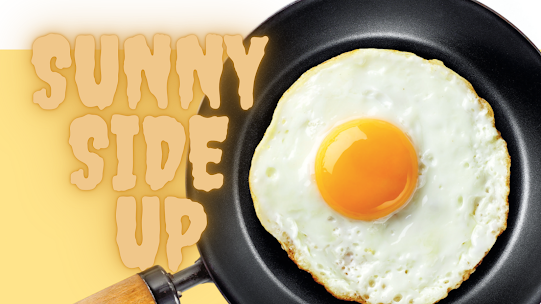Quarter 1 Lesson 4 "Uses of Eggs in Culinary Arts"
Uses of Eggs
Eggs are very useful in preparing and cooking different kinds of dishes, either as a full menu or breakfast dishes. These are also used in baking and bread making. Eggs are an integral part of cookery and can be used for many purposes.
As a binder
It helps other ingredients bind together (eggs are used to help bind together meatballs, and other flour mixtures). When eggs are heated they coagulate (or turns into solid form). As their proteins set, eggs bind ingredients together giving strength and stability to meatloaves, casseroles and baked goods.
As a coating agent
It is called breading. Eggs are used to coat foods with crumbs, flour, etc. as they help these ingredients adhere and also help to create browned appearance when cooked. The breading on fried chickens sticks because the chicken is dipped into an egg, then comes a flour or crumb mixture. The eggs help hold the crumbs to the food when heated during the cooking process and gives the food a crunchier texture.
As thickening properties
Egg yolks are one of the best thickening agents you can use for both your cooking and baking needs. The protein in eggs will thicken when heated and becomes firm. If an egg is cooked for a long time, it will become rubbery. These methods are often used in custard sauce or any other sauce that needs to be thickened.
As an Emulsifier
Proteins in yolks can act as emulsifiers because they have amino acids that repel water and some amino acids that attract water. It permits small globules of one liquid to be inter-dispersed into another liquid. For example, in mayonnaise, the eggs acts as an emulsifying agent in keeping the water and oil together as one product and preventing it from separating out.
As clarifier
Eggs, especially whites, can clarify various fluid products, including broth, consomme, and even wine. When fluid is heated, adding egg whites coagulates, capturing and holding minute particles. Sometimes the whites may bubble to the top where they are skimmed off, resulting in a crystal-clear product. Any unwanted particles in broth will stick to the egg!
As leavening agent
A leavening agent helps to make a cooked product rise. When eggs are beaten, they hold air. When heat is added, the structure will trap the air. This is what makes an angel food cakes, meringues and any baked products light and fluffy. They can act as an additional source of leavening in batters containing baking powder.
Methods of cooking egg
The egg is fried on one side only. This recipe is good for diabetics, heart and weight loss. They add very few calories but a very good dose of protein, B vitamins, calcium, vitamin A, phosphorus and iron too.
Cooking Direction:
- Break the eggs into a bowl before sliding it into the pan to prevent the yolks from breaking.
- Heat a medium non-stick pan over high heat for at least 3 minutes. Low down the heat into medium heat, slide the eggs into a pan carefully so the yolk won't break.
- Cook until whites are set for about 1 to 2 minutes.
- Carefully turn eggs over with a spatula and cook it for 30 seconds.
The whole egg is cooked in simmering water. Boiled egg should not be boiled throughout the cooking process. A method that yields a rubbery results but instead should be brought to a boil and then removed from the heat.
Cooking Direction:
- Place egg in a single layer in a saucepan and cover with 1 inch of cold water.
- Bring to a boil, cover it and immediately remove from heat.
- Let stand approximately 1 1/2 to 2 minutes for soft boiled, 2 to 3 minutes for medium boiled and 12 to 13 minutes for hard boiled.
- Remove the eggs from the water.
Is an egg and milk mixture cooked in a hot pan. Gently move mixture as it cooks. The key to a fluffy, scrambled egg is to beat the eggs briskly for at least 15 seconds before cooking. This incorporates air to produce large puffy curds. Scrambled eggs get pushed around the frying pan as they cook so you get chunks of egg. They are also the most popular egg preparation method.
Cooking Direction:
- In a medium bowl, beat eggs and milk vigorously for a least 15 seconds.
- In a medium nonstick frying pan over medium-high heat, melt 1 teaspoon of butter. When the butter is melted, add the eggs.
- Using a spatula or flat wooden spoon, push the cooked eggs towards the center while tilting the pan to distribute the runny parts. When the eggs are almost set, scramble them gently, and serve immediately.
It is similar to scrambled eggs. Cooking an omelette is typically much more difficult than it appears. Omelettes can also be a nutritious way to eat eggs if you are filling up that fluffy mixture full of veggies. On the other side of the spectrum, frying your eggs is unsurprisingly the least healthy way to prepare them.
Cooking Direction:
- In a medium skillet, heat oil over medium-high heat.
- In a small bowl, whisk together the eggs, milk and seasonings.
- Add the egg mixture to the hot pan. When the eggs begin to cook, add your desired ingredients on top of the mixture. This will prevent the ingredients from burning while cooking on the bottom.
- Reduce the heat, using spatula, gently lift up the edges of the omelette away from the pan.
Poached eggs are raw eggs cooked in hot water or in an egg poacher. Always use the freshest eggs you can find from poaching. The thick albumen of a fresh egg will hold its shape better around the yolk. Add vinegar to the poaching water to help the eggs coagulate faster by preventing the whites from spreading out. Poaching is one of the best cooking methods for creating healthy eggs.
Cooking Direction:
- Bring a large wide saucepan of water and 1 tablespoon of vinegar to a boil.
- Swirl the water carefully.
- Break one egg at a time into a small heatproof bowl, about the size of one egg.
- If the egg is already cooked, use a slotted spoon to removed the eggs.
Garnishes for egg dishes
Eggs are softer with toast in some form. They may be garnished with crisp slices of bacon and a spray of parsley or they may be serves with chopped meat. Eggs are sometimes garnished with grated cheese or cooked egg yolk put through a sieve.








Comments
Post a Comment